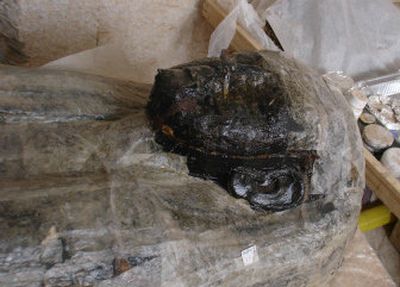Egyptian tomb contains rare trove of flowers

LUXOR, Egypt – Archaeologists hoped the first tomb discovered in the Valley of the Kings in 80 years would hold the mummy of King Tut’s mother. They opened the last of eight sarcophagi Wednesday, revealing no mummies but finding something almost as valuable: embalming materials and ancient woven flowers.
Hushed researchers craned their necks and media scuffled inside the stiflingly hot underground stone chamber as Egyptian antiquities chief Zahi Hawass slowly cracked open the coffin’s lid – for what scientists believe is the first time in more than 3,000 years.
But instead of a mummy, as archaeologists had expected, the coffin revealed a tangle of fabric and rusty-colored dehydrated flowers woven together in laurels that looked likely to crumble to dust if touched.
“I prayed to find a mummy, but when I saw this, I said it’s better. It’s really beautiful,” said Nadia Lokma, chief curator of the Egyptian Museum in Cairo.
The flowers were likely the remains of garlands, often entwined with gold strips, that ancient Egyptian royals wore around their shoulders in both life and death, she said.
“It’s very rare – there’s nothing like it in any museum,” Lokma said.
Dug deep into white rock, the tomb is known only by the acronym KV63 – the 63rd tomb found in the Valley, a desert region near the southern city of Luxor used as a burial ground for pharaohs, queens and nobles between 1500 and 1000 B.C.
The burial chamber was discovered accidentally last year by U.S. archaeologists working on the neighboring tomb of Amenmeses, a late 19th Dynasty pharaoh. It was the first uncovered since the famed tomb of King Tutankhamen in 1922.
Scientists cut a hole in the tomb’s door and got their first glimpse into the 12-foot-by-15-foot chamber in February. At the time, they believed it contained seven sarcophagi, but Lokma said a total of eight were inside.
Since then, the lids of seven of the coffins – including a tiny one built for an infant and filled with feather-stuffed pillows – were peeled back one by one, revealing pottery shards and fabric but no mummies.
With the last opened Wednesday, the tomb still had more mysteries than answers.
Lokma hoped hieroglyphs would help scientists identify who the coffins and tomb were made for and what happened to the bodies.
The discovery broke the long-held belief that nothing is left to dig up in the Valley of the Kings.
Hawass, who heads the Egyptian Supreme Council of Antiquities, said he believed the new tomb could have belonged to King Tut’s mother. Closely related Egyptian royals tended to be buried near each other and graves of the rest of Tut’s family have already been found, he said.
“It would make sense; his tomb is so close that it looks like he chose to be buried next to his mother,” who died years before the young king, Hawass said.
The tomb may also have been used as a secret embalming chamber under later pharaohs before being forgotten for centuries, Lokma said.
Though the new discovery did not compare with the marvels of golden masks, jewels and statues found in Tut’s tomb, experts said it was a major scientific discovery that could ultimately catapult understanding of ancient Egypt.